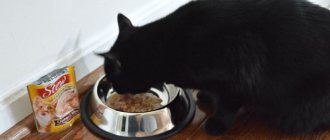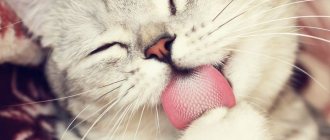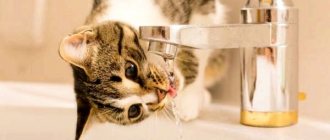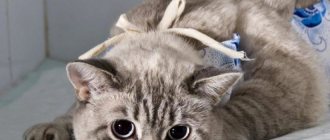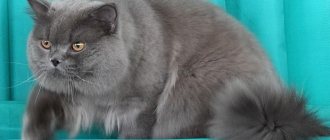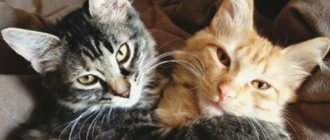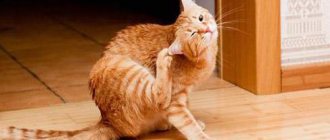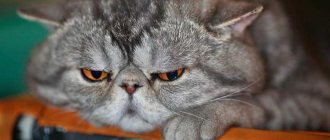Let's face it, a cat is not the most comfortable of pets, nor the most useful. But cats are definitely among the most beloved pets. It's hard not to love cats, at least for their expressiveness. They convey their feelings, intentions, attitude to what is happening, mood and emotions with the help of rich facial expressions, body movements, and sounds. Even a cat's eyes are incredibly expressive! And in especially severe cases, cats have to be exposed to odors.
How to understand “cat language”? The article will try to give answers to questions that concern all cat lovers.
Let the cat come to you first
When you adopt a new kitten, don't try to shower it with all your love and care right away. Let him first get used to it, understand where to find food and toys. It’s better to watch from the side for a while: if everything is fine, the pet will come up to meet you. All you need to do is not pay too much attention to him, because cats love freedom.
Voice communication
One of the most important tools with which cats transmit information is their voice. A cat's voice helps to communicate both with other cats and with humans. Even cats meow with different intonations: it’s one thing when a cat asks for food or a walk, another when it meets its owner after separation, and a third when it protests against being treated too freely. In these cases, our tailed friends perfectly convey information by voice.
Cats can make a variety of sounds, ranging in pitch from 75 Hz to 1.52 kHz. Usually meowing in a high tone means complacency, pleasure, tenderness. A low “meow,” almost a growl, is used to express aggression, fear, irritation, and pain.
When communicating with kittens, cats often go into the ultrasonic range, which humans cannot perceive. Such communication is only for our own people.
Experts count sixteen different sounds of “cat tongue.” The most talkative breeds are considered to be of eastern origin - Siamese and Orientals.
Among cat sounds, “noise” sounds are distinguished, which include purring and rumbling. Cats don't even have to open their mouths to make these sounds. These sounds are unique to small cats and mean greeting, pleasure, a desire to receive approval - in general, positive emotions. Purring cats demonstrate a complete lack of aggression. Thus, nursing mother cats purr when addressing their kittens, and the kittens themselves purr when they suckle their mother. In the latter case, it is a kind of loud chatter. Cats also purr when greeting their owners. At the same time, they often rub their heads and sides.
An excited cat often makes completely different purring sounds - these are more likely warnings of danger or something unknown. It means that the cat is ready to defend itself, and is addressed either to people or other animals (including kittens).
Another characteristic cat sound is hissing. This is an indicator of an extreme situation: hissing is the sound of despair, the sound of a situation when you are scared and have nowhere to run. A cat's hiss sounds like a snort. In this case, cats also lean forward and hit the ground with their paws, showing their readiness to attack.
Cats use snorting when attacking a more dangerous enemy when there is nowhere to retreat. This is an indicator of despair and combat rage. Sometimes, in fact, snorting means confusion that the cat is experiencing, not knowing whether to fight or whether it is better to hide.
Even if you are the owner of a cat, it is better to take snorting seriously. Perhaps the reason is your obsessive attention. Then you should leave the animal alone.
Sometimes (in rare cases) you can hear cats chattering their teeth. This is a hunting sound, meaning to attract attention to the prey. It is addressed not only to the cat herself, but also, say, to the kittens that she teaches to hunt. You can hear this sound, for example, when a cat sees a bird through a window.
Meowing is an equally diverse class of sounds. These are a kind of “vowel sounds” of cat speech. They can be written as “meow”, “miu”, “miau”, “meeu”, “mew”, conveying different nuances of meowing. Over time, the owners begin to understand the accents and semantic meaning of different sounds.
Cat talk is varied. Meowing of different types can mean “I’m hungry” (alternatively – “I’m really hungry!”), “Let me out for a walk”, “Help!”, “I’m bored!” and so on. Each cat has its own style of “speech”, its own recognizable manner. Owners of several cats will confirm: by meowing you can find out exactly who is making it without looking.
When meowing, a cat's mouth is usually tense. Sometimes this takes the style of meowing to the most extreme forms - screaming, screaming, what is called a “cat concert”. This usually happens during the mating season, in the spring, but there are exceptions.
The verbal richness of cats develops as they grow. Usually, cats open up in full voice at 3-4 months and later. Kittens can only hiss, squeak, purr, purr and sometimes snort. Their voice is revealed, on the one hand, when they learn from their mother, on the other, under the influence of the environment. So just be patient and your kitten will become a real communication genius! And you will understand it perfectly, regardless of whether you want it or not.
Set up a place to relax
A cat needs a personal space where it can go if it doesn’t like something and calm down there. If she scratches, bites and wags her tail in displeasure, do not hold her near you. Let yourself come to your senses, wait until she approaches you again. By doing this, you show her that you respect her interests - and she will respond with even greater affection and devotion.
Facial expressions
Facial expressions – not only from the word “mimimi”. Although cats can indeed be extremely pleasant and touching, with their facial expressions they are capable of expressing a much wider range of emotions. From birth, cats show their emotions through gestures, facial expressions, movements and postures. Unlike meowing, sign language is available to kittens from a very early age. It’s worth watching kittens play to understand that with their bodies they express everything that adult cats do.
By the way, of all domestic animals, cats have the most expressive facial expressions. Sometimes they look SO much that everything becomes clear even without sounds! Thanks to very mobile facial muscles and huge eyes, capable of conveying a wide variety of emotions and moods.
If the cat has half-closed its eyes, it means that it is in a relaxed, peaceful state of mind. On the contrary, wide open eyes raise the question: what do you see there, you cat's face? It means surprise, concern, interest. Fear is expressed in a similar way, but the pupils are greatly dilated.
Be afraid of the cat when it stares or squints! It doesn't matter what size you are or what size she is: it means a challenge. At this moment, her pupils narrow, and her attention concentrates on the offender or victim. And if the cat recognizes that you are more important and stronger, she averts her eyes. That's it, you can pet it, just be careful.
Another expressive part of a cat's body is the ears. Watch the ears: if they are directed forward, it means the cat is interested in something, but not aggressive. She can also greet someone with a similar gesture. If your ears droop to the sides of your head, be careful: this is a sign of aggression. If the cat's ears are pressed to the back of the head, it means that the animal is scared and does not understand what to do. Insecure or irritated cats have a characteristic ear flutter.
You shouldn't neglect your head position if you want to understand cats. A strongly lowered head is also an indicator of an aggressive mood. A slightly lowered one indicates confusion.
Cat eyebrows and whiskers can also be easily counted. If the whiskers are directed forward, it means the cat is focused. She may be curious, excited, or tense. Flowing whiskers mean the cat is calm. In an alarmed animal, they are pressed to the cheeks and collected in bunches.
Watch the mouth! Often cats show pleasure by slightly opening their mouths and sticking out their tongues (Persian cats especially abuse this). A relaxed animal can allow itself to yawn - sweetly, protractedly, exposing its tongue and almost all its teeth. On the contrary, if a cat intends to bite, then its mouth is clearly open, and its lips are tense or even its teeth are bared. An anxious cat may begin to lick its lips and grin. The so-called “Flemin smile” is an indicator that the animal is interested in the smell. If it's a cat, then it probably smelled the cat, and vice versa.
Cats express a lot through touching and sniffing. Thus, they may clarify their social hierarchy by sniffing each other's temples, mouths or hindquarters, or even licking them. The cat at the top is the one that shows interest, and the cat at the bottom, on the contrary, allows itself to be licked and sniffed.
Friendship in cats is manifested through touching their noses or pressing their heads to each other. You may have noticed this when a cat rubs against your legs, making incredible shapes. Sometimes she asks you for something (to feed you or let her go for a walk), sometimes it’s just a sign of sympathy. You should be especially flattered if a cat affectionately butts you, making “bushes”: only a select few, the most significant persons, are awarded this affection.
Cats and cats actively communicate using gestures with their paws and retractable claws. Cats need paws not only for walking and running, but also for playing, hunting, intimidation, and exploration. If the cat is irritated, watch his front paw: he may hit. True, if he only intends to warn, then he will not release his claws. This blow is intended for a person who has gone slightly overboard. This is how a mother cat can lightly hit a kitten that is playing.
Sometimes cats stretch their paws towards the face of the person playing with them. The natural instinctive reaction is to close your eyes and cover your face. But it normal. In this case, cats usually do not release their claws. They hint that it would be nice to get up and give them attention or, conversely, let them in under a warm blanket (if the cat likes that).
Some adult animals behave like kittens throughout their lives. For example, they can purr with pleasure and move their front paws. This is how kittens behave when they suck milk from their mother's nipples. Moreover, sometimes cats strive to suck on the first object they come across.
Eye contact
Cats do not tend to communicate with humans through voice, except in rare cases.
The main way of communication between a kitten and a person is visual contact. To let your pet know that there is no danger, he is loved and accepted, you can use the following methods of conveying information: We also recommend reading:
Pet: why does the dog refuse to go for walks When and why do kittens change eye color? Why a cat won't accept kittens, and how to deal with it Unusual facts about the cat's nose
- cats do not like direct eye contact, so they often seek communication with those who are indifferent to them and do not pay attention;
- if the kitten is in a calm state, try to lie next to it and look into the baby’s eyes, after responding with the pet’s gaze, slowly close your eyes, then open them (do this repeatedly). You need to wait until the kitten repeats the owner’s movements;
- During exercises with closing your eyes, you need to ensure that the cat turns away, making it clear that he does not see you as a threat (this does not always work the first time).
Do not try to look into the animal’s eyes for a long time; they may take this gesture as a signal for aggression or attack. Cats are not as attached to their owner as dogs. Therefore, you should not expect them to want to constantly be near a person.
How will the relationship between the two pets develop in the future?
No one is able to predict with one hundred percent certainty how the relationship will develop in the future. The owner’s task is to regulate the cat’s behavior during the first days of acquaintance. Then, when the likelihood of fights drops to zero, the animals will decide for themselves whether to be friends or simply ignore each other.
At best, the “neighbors” will become friends and become good friends. They will play and sleep together, protect each other from strangers. But there are other scenarios. For example, two cats are able to remain indifferent or continue to compete with each other until the end of their lives.
Common causes of conflict between pets
It is possible to accustom fluffies to life within the same apartment or house. However, this will require patience and effort on the part of the owner, especially if the cats have character. It is quite difficult to predict how pets will behave during acquaintance and further communication.
The reasons that usually provoke conflict are:
- refusal to live in one territory;
- reluctance to share the attention of a loved one;
- different gender and age;
- fear of a new neighbor;
- aggressive behavior of one of the cats;
- psycho-emotional characteristics of animals;
- physiological characteristics (sterilized, pregnant, lactating).
All this must be understood before taking a new pet into the family. Many mustachioed friends feel good alone. It’s not always worth getting another furry just so that the first one doesn’t get bored. In order for two cats to live in the house and not cause problems with their behavior, you will have to make a lot of effort and develop cunning tactics.
Communication by movement
The incredible expressiveness of cats is also evident in their body movements. The cat's tail has become a proverb, by which one can understand the emotional state of the animal without even seeing the face. If an animal holds its tail like a pipe, then it is clearly in a great mood and is friendly. This condition is especially common in kittens. So, if a cat rubs against your legs, tries to play, expresses pleasure, then its tail will probably be raised.
On the contrary, a lowered tail, on which the hair is raised, indicates wariness. In a confused cat, the hair on the tail rises only at the base. If a cat is scared, it hides its tail between its paws.
When an animal is aggressive, it raises its tail high, it is tense and completely spread out. Cat lovers know: if a cat twitches its outstretched tail, this is not good. The animal is clearly irritated by something. Just a tail thumping on the floor betrays fear. But if the cat's tail twitches to the sides, if the cat hits itself on the sides with its tail, then it is better to remove your hands: the animal may scratch or bite you.
You can swing your tail with different “intonations”. So, if a cat waves only the very tip of its tail, this means a relaxed state. And a hunting cat moves its entire tail. He starts out slow and gradually speeds up, so that even his rump vibrates before he jumps.
The cat's poses are no less eloquent. We are used to thinking about fit, graceful beauties stretching out their slender bodies. But the huge, imposing cat is also capable of taking very eloquent body positions. A pose is not only an expression of the internal state, but also a message for the cat’s “interlocutor”. For example, a warning addressed to another cat will be very different from the posture a cat adopts when faced with a dog or other formidable opponent.
The classic pose when facing a threat is the hump. In this position, the cat is tense, visually it appears larger than usual. It is characterized by elongated paws, elevation, arched back, and a crocheted tail. The fur also stands on end. The cheeks of a frightened or attacking cat are very mobile, they shake. The head appears larger due to the raised fur. The nose wrinkles, the mouth is open, the corners are pulled back, exposing the fangs, and the ears are pressed to the back of the head. At the same time, the cat emits aggressive rumbling and hissing.
The distance between the cat and its opponent is also very important. Animals perfectly sense the danger distance at which the enemy is able to attack, and strive to stay out of reach. Cats do not go beyond this line, even demonstrating their readiness to attack. The enemy must get closer himself so that the cat shows aggression itself. Until this point, it is limited to a warning.
The exception is the mother cat, who protects her kittens. She is capable of attacking from any distance and is usually the first to attack. She jumps on all fours, stands sideways to the enemy, raises her tail high and spreads her fur on it. This pose means readiness to fight with all available means, to the death.
In other situations, cats that are not so radical look different. For example, if animals are simply measuring their strength, they simply raise their backs slightly, without creating a hump, and slightly fluff the hair on their tail and withers. They can get close to each other without getting into a fight. Standing nose to nose, they can remain almost completely motionless for a long time. In this case, the cat’s mood is revealed only by its moving tail, lashing at the sides.
When cats move from demonstration to action, usually one will hit the other on the nose with its paw. As the fight begins, the attacking cat strives to grab the other by the back of the head in order to throw it on its side. If the animal does not want strength development, it can take an aggressive defensive pose: press into the floor or fall on its back or side, putting all four paws with claws out.
The fight usually ends abruptly. The satisfied winner leaves first, slowly and with dignity.
Typically, cats do not resort to threats when communicating with people. Their aggression, as a rule, is neutralized by the long-term habit of living together, which smoothes out the reaction towards the owner. Even if he tries to grab the cat by the scruff of the neck or behave in a not entirely polite way, the animals often treat this tolerantly. It’s another matter if someone outsiders encroaches on the dignity of an animal. Then all means are good. An impudent guest may think that he got off easy if the owner's cat only scratched his hand. By the way, the owner is not at all obliged to apologize for such behavior of an animal that was simply defending itself.
Cat poses are absolutely magnificent when the animals are in a complacent, happy mood. The most striking manifestation of happiness is a cat lying on its back or side. At the same time, the vulnerable belly is open, the paws are scattered to the sides, the claws are tucked, the pads can open and close. Often cats close their eyes, sometimes the third eyelid becomes visible, so suspicious owners can rush to call the veterinarian. In fact, this is a completely healthy state of trust. Residents of private homes can often see cats languishing in the sun or near a heater in a similar way. Apartment cats can be found in this state on a sunny balcony.
If the cat doesn’t know what to do, he always licks his fur. Making sudden movements with its tongue, the animal simultaneously solves quite complex problems in its mind. “In any unclear situation, wash your face,” this could be expressed in an Internet meme.
Licking has a fairly important task. It neutralizes aggression and allows you not to indulge in irritability as the first emotion. So, you can notice that cats constantly lick their kittens. This is not just a concern for cleanliness, but also a call for calm and a sign of intimacy.
Cats perfectly feel how relaxed or tense the psychological atmosphere reigns in their home. A hairless cat (unless it's a sphinx!) is an indicator of a nervous, tense spirit at home. Often cats lick themselves to the point of partial baldness due to loss of attention to them (for example, the owners often quarrel, disappear at work, often go on business trips, they have a child, etc.)
— How many cats do you have and where are they from?
— There are seven cats. Their names are Kys, Lynx, Plush-Leksyush, Sir Max, Sanya the Cat, Sem-Sem (Semyon Semyonovich) and Penguy. Most of them are refuseniks and recruits.
Kysenka came to me at the age of three weeks, when he still couldn’t really eat. This was my first cat, my first pet. I got Lynx six months later. He is a conscientious receiver. The previous owners took it as a decoration for the sofa and returned it a week later - they say that the “decoration” does not want to decorate anything.
With Lexyusha I started as a felinologist. He came to me from very disadvantaged conditions. As a small kitten, he was taken into a family for a girl, who two months later had enough of playing and said: “Please take him back, mommy-daddy, and bring me the little one again.”
The cat was not thrown out, but left in a country house. From 3 to 9 months he sat in the attic - this means complete deprivation of communication at the age when the kitten is socializing and forming its view of the world and people. When he came to me, he had a lot of problems. Firstly, the “blockade syndrome”. He ate with terrible force until he vomited in the bowl. Secondly, the dust in the attic caused his paw pads to crack and bleed. We treated the little paws for a very long time. But the worst thing happened to his psyche. The kitten had a terrible fear of swinging. I don’t know what this girl was playing with him, but the kitten was afraid of hands. His nose was broken. He was afraid of people and did not know how to communicate with other animals. Sad story.
Then I worked as an assistant in a veterinary clinic and turned to my colleagues for help. They said that a behavior correction specialist was needed here. As it turned out, there are many such specialists in dogs, but in cats there are much fewer. We can say that 5 years ago they practically did not exist.
One of my friends advised me to contact Yulia Islamova. She is a specialist in behavior correction for dogs and cats. I invited her for a consultation. It was 4 hours that completely changed my life and my idea of cats. And at that time I considered myself an experienced cat lover. Thanks to her, Leksyusha came to his senses.
